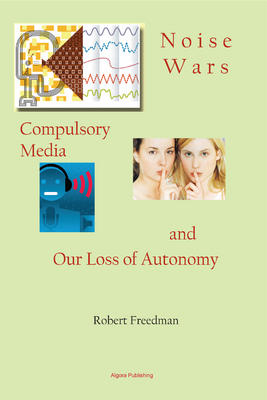
Sound Bite
Let me place on your radar screen an issue that for most people goes by unnoticed. Every day it is there for all of us to see and hear if we can just notice it for that first time. This is the rising use of media, the use of media in abusive, penetrating ways. Our freedom to choose whether or not we consume that media is taken away from us.With their business model coming under pressure from shrinking audiences, media companies seek to regain their footing by forcing people to consume TV and other digital content outside the home by turning public and private settings into captive-audience platforms. In this book Robert Freedman looks at how consumers are putting up resistance to being held captive to TV on buses, trains, elevators, taxis, subways, office lobbies, schools, stores, and street corners.
About the Author
Robert Freedman has been a journalist and communications professional for 30 years. He studied philosophy in the Ph.D. program at the University of Nebraska and has a Masters in Humanities from Marymount University. He is the author or editor of five previous books including 'Noise Wars' (Algora Publishing, 2009), which looks at the rise of captive-audience media. Freedman is also editor and publisher of “Rush Vault,” the 1,500-page website on all things Rush. He lives in Alexandria, Va.
|
|
About the Book
Robert Freedman looks at the role of media in society in a unique way by focusing exclusively on the emerging trend of audience captivity: the relocation of TV and other intrusive electronic media from our home, where we have personal control over...
Robert Freedman looks at the role of media in society in a unique way by focusing exclusively on the emerging trend of audience captivity: the relocation of TV and other intrusive electronic media from our home, where we have personal control over it, to all the settings outside the home in which we donÃ??'t have control: buses, subways, taxis, elevators, retail stores, hotel and office lobbies, street corners, street furniture, and gas station pumps, among others.Although the book comes down squarely against audience captivity as a media business model, it takes a conversational, even-handed approach that lets the facts speak for themselves. It does this by showing on the one hand the growth of captive-audience platforms and on the other the rise in people's resentment even anger at being made captive to electronic media they haven't asked for and from which they can't escape without personal cost.By approaching the topic in this way, the book makes a compelling case that the media industry's growing reliance on audience captivity as a business model is setting up a values war not unlike the war between smokers and opponents of second-hand smoke. As the first systematic look at audience captivity from a social perspective, the book makes a crucial and timely contribution to research on and discussions about media and society.This book offers resources, ideas and tools for people who care about the proper role of television and other electronic media in their lives and the lives of children. Consumers who are interested in media and society, and groups such as the Campaign for a Commercial-free Childhood, Action Coalition for Media Education, Commercial Alert, Center for Screen Time Awareness, Center for Successful Parenting, and Parents Television Council, will find this book of high interest.
|
©2009 Book News Inc. | More »
©2009 Book News Inc.
Though the freedom of media corporations to barrage people with anything anywhere anytime has been sanctified by US courts, veteran American business journalist Freedman argues that digital media differs considerably from print and broadcast media, and should be treated — and regulated — separately. Among his topics are gas station TV, profit versus rights, other people's sell phones, the loudest urban environment on earth, the usurpation of autonomy, privacy filters, and inadvertent captivity.
|
|
Pages 220
Year: 2009
LC Classification: HM1206.F74
Dewey code: 302.23 dc22
BISAC: SOC052000 SOCIAL SCIENCE / Media Studies
Soft Cover
ISBN: 978-0-87586-714-4
Price: USD 22.95
Hard Cover
ISBN: 978-0-87586-715-1
Price: USD 32.95
eBook
ISBN: 978-0-87586-716-8
Price: USD 22.95
|













